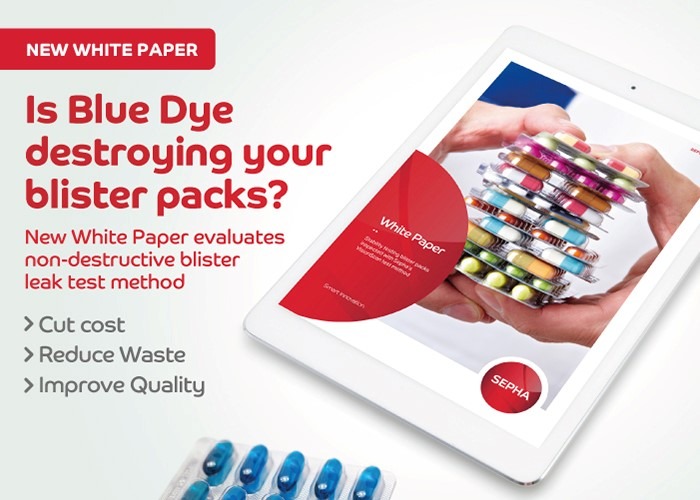New White Paper: Non-destructive Blister Leak Test Method


When discussing the Sepha VisionScan with pharmaceutical manufacturers, one of the questions often asked is ‘Do you have scientific proof your blister leak test method does not affect package integrity’? Until now, we were confident our blister leak testing solution was non-destructive, however we can now justify this claim in a new white paper called ‘Stability Testing Blister Packs Inspected with Sepha’s VisionScan Test Method’.
Pharmaceutical Leak Detection
Technology-based integrity testing offers pharmaceutical packaging operations increased efficiencies by utilising non-destructive techniques as part of the process. Calibrated and validated technology-based solutions offer a deterministic and repeatable test compared to traditional methods. Dye ingress tests like blue dye are often subjective, probabilistic and not as sensitive in their ability to detect a defect.
In this white paper, published by Dr Dorian Dixon from the University of Ulster, a stability study was conducted to test the hypothesis there is no significant increase in the moisture status of tablets inside a blister pack inspected by the VisionScan test method compared to blister packs in the control group. Independent research company Relequa used its Moisture Profiling™ technique to investigate the barrier performance of blister packs. Packs were made with different material types and the moisture levels of the tablets in each pack were measured over a 12-week period.
Blister Pack Materials
Xylitol tablets were sealed inside blister packs with three different material types including:
- PVDC coated PVC blister sealed with aluminium 20µm hard lidding material
- Aclar® (PVC/PE/PCTFE) blister sealed with aluminium 20µm hard lidding material
- Aluminium cold formed blister sealed with aluminium foil (Alu/Alu) comprising of a polyamide/aluminium/PVC laminate
Non-destructive Blister Leak Test Results
The results of the study show no significant difference in moisture uptake between the inspected and control blister packs of any of the three material types. This shows the VisionScan leak test method, does not compromise the integrity of the blister pack and confirms our method truly is non-destructive.
Results from a previous white paper already showed the Sepha VisionScan can identify 100% of defective pockets across a range of blister pack types. Adding the results of this new study proves that the Sepha VisionScan can offer a significant contribution to the quality control process of pharmaceutical packaging.
Blister Leak Test USP 1207, cGMP & ASTM Standards
Packaging integrity testing is an essential part of the packaging process, being driven by USP 1207 guidelines, cGMP and ASTM standards. While traditional, destructive methods are still within these guidelines, we see a trend in more companies looking for alternative solutions that have less environmental impact in terms of waste and that can reduce cost in terms of lost products, lost packaging materials and disposal/incineration cost.
To sum up, this new evidence can help these and other pharmaceutical companies as it proves our method does not compromise the package integrity, therefore does not negatively affect the product inside, enabling manufactures to reuse the products and put them back on their line.
Interesting links:
VisionScan Product Page
VisionScan White Papers
Other Leak Testing Solutions